Asian Citrus Psyllid and Citrus Greening Disease
By: Joseph L. Knapp, Susan Halbert, Richard Lee, Marjorie Hoy, Richard Clark and Michael Kesinger
The Asian citrus psyllid (AsCP), Diaphorina citri Kuwayama, was first detected in Florida by Susan Halbert on June 2, 1998. Its current distribution is along Highway 1 on the east coast of Florida from Broward to St. Lucie counties and is apparently limited to dooryard host plantings. This exotic insect is not now regarded as a major pest in and of itself; however, it is the vector of a serious bacterial disease called citrus greening (CGD) (Liberobacter spp.). In Asia, the major pathogen is L. asiaticum. AsCP could be the most serious pest of citrus in Florida if the bacterium causing CGD is also present. If the pathogen is absent, AsCP is usually regarded as a minor pest. Surveys to date have not detected the presence of the CGD organism in Ronda.
A close relative, African citrus psyllid, Trioza erytreae (del Guercio) that vectors citrus greening disease in Africa (L. africamum) will not be discussed here.
Distribution
Present throughout most of southeast and southern Asia, South America, Guadeloupe and Florida with unconfirmed reports from Central America. How it got to Florida and where it came from is not currently known. Survey work is continuing to determine its distribution in Florida.
Description
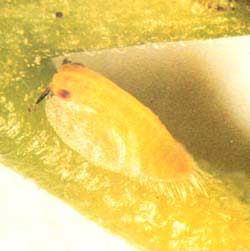 Adults are about the size of aphids, 2-3 mm (0.08-0.12
inches) long; the body is mottled brown; head light brown; the wings
have distinct bars on the top and bottom, giving the insect a flattened
x-pattern when viewed from the side; antennae with black tip; living
insect covered with whitish, waxy secretion, making it appear dusty.
Adult AsCP exhibit jumping behavior which will distinguish them from
sluggish aphids. Nymphs are small and difficult to see, 0.25-1.7
mm long; color generally green to yellowish-orange with no abdominal
spots; may resemble the green scale, but psyllid nymphs have large
wing pads. Eggs are 0.3 mm long, elongated, football shaped; being
deposited on new flush with the long axis vertical to surface. Color
ranges from pale to yellow to orange as they reach maturity.
Adults are about the size of aphids, 2-3 mm (0.08-0.12
inches) long; the body is mottled brown; head light brown; the wings
have distinct bars on the top and bottom, giving the insect a flattened
x-pattern when viewed from the side; antennae with black tip; living
insect covered with whitish, waxy secretion, making it appear dusty.
Adult AsCP exhibit jumping behavior which will distinguish them from
sluggish aphids. Nymphs are small and difficult to see, 0.25-1.7
mm long; color generally green to yellowish-orange with no abdominal
spots; may resemble the green scale, but psyllid nymphs have large
wing pads. Eggs are 0.3 mm long, elongated, football shaped; being
deposited on new flush with the long axis vertical to surface. Color
ranges from pale to yellow to orange as they reach maturity.
Damage
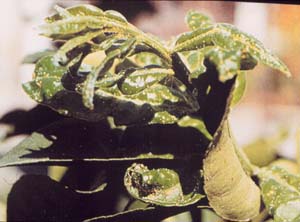 Feeding injury by AsCP is similar to that of aphids causing
leaf distortion and curling which results from the withdrawal of
sap from the foliage. Sooty mold will develop on the honeydew-covered
leaves. The vectoring of CGD will be discussed later.
Feeding injury by AsCP is similar to that of aphids causing
leaf distortion and curling which results from the withdrawal of
sap from the foliage. Sooty mold will develop on the honeydew-covered
leaves. The vectoring of CGD will be discussed later.
Life History
Eggs hatch in about 2-4 days. A female lays up to 800 eggs during her lifetime of several months. There are five nymphal instars. The complete life cycle ranges from 15 to 47 days depending upon food and temperature. This may result in up to 30 overlapping generations per year in Florida.
Dispersion
AsCP are weak fliers and are spread long distances primarily by wind and man.
Hosts
All citrus plants and close relatives including Murraya (orange Jasmine), Severinia, Clausena, Fortunella and others.
Survey and Detection
Sooty mold on foliage indicates related insects such as soft scales, mealy bugs, whiteflies, aphids or psyllids. Adult AsCP are found in large numbers on stems and the lower sides of the leaves sitting upside down at a 45 degree angle with heads almost touching the plant surface. When disturbed, they may leap and fly short distances. AsCP nymphs are found on new growth and move in a slow, steady manner, but are difficult to see.
Management
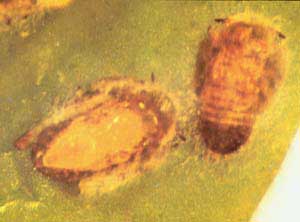 Chemical intervention to reduce AsCP populations without the disease
organism is not recommended at this time. As with the citrus leaf
miner, some control may be warranted at some later date to reduce
populations in nurseries and newly planted groves or on resets. This
will be determined through observations of population densities and
their effect on tree growth and vigor.
Chemical intervention to reduce AsCP populations without the disease
organism is not recommended at this time. As with the citrus leaf
miner, some control may be warranted at some later date to reduce
populations in nurseries and newly planted groves or on resets. This
will be determined through observations of population densities and
their effect on tree growth and vigor.
Biological
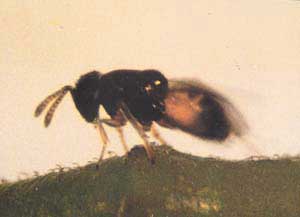 Two parasites will be introduced from Thailand, Taiwan
and/or Vietnam. After clearing quarantine, these parasites will be
released as appropriate. AsCP does not tolerate sustained high humidity,
which results in fungal epizootics similar as occurs with citrus
rust mites and the Hirsutella fungus.
Two parasites will be introduced from Thailand, Taiwan
and/or Vietnam. After clearing quarantine, these parasites will be
released as appropriate. AsCP does not tolerate sustained high humidity,
which results in fungal epizootics similar as occurs with citrus
rust mites and the Hirsutella fungus.
Tamarixia radiata is an effective parasitoid of the citrus psylla, Diaphorina citri Kuwayama, in Asia. These psyllid nymphs have been killed by the feeding of the immatures of this eulophid ectoparasitoid.
Regulatory
Regulations to control possible spread of CGD are needed until we are reasonably sure that the citrus greening pathogen is not currently in Florida. In order to prevent long-range movement of the AsCP and particularly the citrus greening pathogen, the Division of Plant Industry will require that plants for sale in nurseries be free of AsCP. Nurseries and stock dealerships will be inspected for AsCP. If plants are found infested, the business will be required to sign a compliance agreement wherein treatment and control of AsCP is specified. In general, the same management practices that prevent colonization by brown citrus aphids will also work for AsCP.
Budwood Protection Program
Recent pest and disease introductions into Florida emphasize the need for Florida's Citrus Budwood Protection Program. The budwood program is mandatory. The program requires identification of all sources of propagating material and is one of the first lines of defense in reducing long distance spread of diseases. The Citrus Budwood Protection Program is guided by a technical advisory committee of nurserymen, growers, researchers and regulators who provide input into the program's direction. The committee is charged with recommending testing strategies to manage new diseases such as CGD or citrus variegated chlorosis. The industry has been proactive during the past five years in strengthening this valuable protection program before citrus greening or citrus variegated chlorosis are found in Florida.
Citrus Greening Disease
Pathogens that cause CGD are phloem-limited bacteria in the genus Liberobacter. To date, Liberobacter sp. have not been reported in the Western Hemisphere. Where the disease occurs, the following has been reported:
Symptoms
CGD results in a chronic decline of citrus. In places in Asia where severe CGD is endemic, citrus lives an average of five to eight years. The disease is usually characterized by a blotchy mottle on leaves. The leaf veins often initially turn yellow. Later leaf symptoms may resemble zinc deficiency. The disease usually begins in one branch or sector of larger trees and gradually spreads throughout the tree. On branches or trees affected by greening, the leaves are small, point upright, and show chlorosis. Fruit from infected trees are small, misshapen, and have a sour or bitter flavor, whereas fruit from trees affected with severe citrus tristeza virus (CTV), blight, or stubborn are sweet. Seeds in symptomatic fruit are usually aborted, and the fruit remains green on one end. Premature fruit drop occurs. Asian CGD expresses symptoms strongest in warm temperatures.
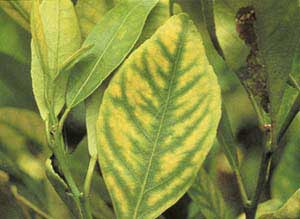 Differentiation from Other Tree Declines
Differentiation from Other Tree Declines
Symptoms of CGD that are useful for differentiation from other chronic tree declines such as severe CTV, blight, and citrus variegated chlorosis:
- Yellowing of leaf midrib and veins. Early in symptom development the veins may be slightly swollen.
- Seeds are aborted in the small, misshapen fruit. The fruit, especially small fruit, have a bitter taste compared to the sweeter taste imparted by other diseases.
Hosts of Greening
All Citrus and relatives are potential hosts. Sweet orange, tangelo, and mandarins are most susceptible; grapefruit, lemon and sour orange are moderate in susceptibility; and limes. pummelo and trifoliate orange are the least susceptible.
Symptoms have been observed in Microcitrus australasica, Swinglea glutinosa, Atalantia missionis, Clausena indica, Limonia acidisimma, Balsamocitrus dawei, Aeglopsis chevalieria, Severinia buxifolia and Murraya paniculata. Most of these hosts are identified by symptoms only. Catharanthus roseus (periwinkle) and Nicotiana xanthii (tobacco) are the only reported non- Rutaceous hosts. Both of these latter hosts were infected only under laboratory conditions.
Detection Methods
Electron microscopy, monoclonal antibodies and polymerase chain reaction (PCR) assavs have been used for detection. Sweet tangor, Duncan grapefruit, and sweet orange seedlings are commonly used indicator plants. A staining technique using gentisic acid has been used for survey work.
Spread by Vectors
Transmission of CGD is by AsCP in a persistent manner, i.e. bacteria multiply in the psyllids. AsCP is reported to acquire the bacteria in 15-30 minutes of feeding. There is a latent period of 8-12 days after which transmission can occur. Transmission rates of up to 100 percent have been reported. The fourth and fifth instar nymphs can acquire citrus greening bacteria and transmit the disease as nymphs or adults. The greening bacterium can be found in the haemolymph of the vectors. Under laboratory conditions, AsCP can transmit both Asian and African citrus greening bacteria.
We thank Dr. Rut Morakote, Department of Agriculture, Bangkok, Thailand, for the use of the photographs on this page.
1 Knapp and Lee work at Lake Alfred's Citrus Research and Education Center where Knapp is a professor, entomologist and Lee is a professor, plant pathologist; Halbert is a biological scientist with the Division of Plant Industry in Gainesville. Hoy is an eminent scholar with the University of Florida's Department of Entomology and Nematology at Gainesville. Clark is chief of the Division of Plant Industry's Bureau of Plant and Apiary Inspection at Gainesville. Kesinger is chief of the Division of Plant Industry's Bureau of Citrus Budwood Certification at Winter Haven.


